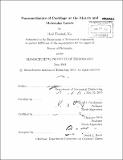| dc.description.abstract | Cartilage, as well as many soft connective tissues, functions mechanically across a wide spectrum of daily loading frequencies (time scales), from <1 Hz in slow activities such as walking, to 1000 Hz for high-rate activities such as jumping and impact sports. A major mechanism underlying the macroscale mechanical functions of cartilage is known to be poroelasticity, based on previous theoretical and experimental studies. Poroelasticity manifests itself via fluid-solid frictional dissipation and intra-tissue fluid pressurization that underlie important mechanical functions of cartilage, especially frequency-dependent self-stiffening, load-bearing, energy dissipation, solute and fluid transport, lubrication and mechanotransduction. More recently, nanoscale methodologies have been employed to study cartilage function under quasi-static and low frequency loadings. However, the nanoscale full-frequency spectrum of poroelastic behavior, which is critically important to the understanding of molecular level fluid-solid interactions in dynamic loading, has not been well-studied. How does the molecular structure of cartilage provide optimal tissue-level function over the wide spectrum of daily joint motions, what are the molecular mechanisms underlying this optimal function, and how does impact loading induce molecular-level degradation of the extracellular matrix (ECM) that occurs at the earliest stages of post-traumatic osteoarthritis? In this thesis, atomic force microscopy (AFM)-based oscillatory loading was employed in conjunction with finite element modeling to quantify and predict the frequency-dependent mechanical properties of articular cartilage at deformation amplitudes [delta] ~ 2 - 15 nm; i.e., at length scales less than the dimension of single collagen or aggrecan molecules. The magnitude lE*l and the phase angle p of the dynamic complex indentation modulus were first measured in the frequency range, f ~ 0.2-130 Hz. For fresh, normal cartilage, the experimental frequency and length-scale dependence of lE*l and [pi], corresponded well with that predicted by a fibril-reinforced poroelastic model over a 3-decade frequency range. Hence, these results suggest that poroelasticity is the dominant mechanism underlying the frequency-dependent mechanical behavior observed, even for these nanoscale deformations. Second, a new AFM-based wide-frequency rheology system was developed to extend the typical frequency range of commercial AFMs (i.e., 0.1 - 300 Hz) to the much wider frequency range of 0.1 Hz to 10 kHz. The dynamic nanomechanical behavior of normal and glycosaminoglycan (GAG)-depleted cartilage (the latter representing matrix degradation that occurs at the earliest stages of osteoarthritis) were measured. The dynamic modulus of cartilage was found to undergo a dramatic alteration after GAG loss even with the collagen network still intact: while the magnitude of the dynamic modulus decreased 2-3-fold at higher frequencies, the hydraulic permeability increased up to 25-fold, suggesting that early osteoarthritic cartilage is more vulnerable to higher loading rates than to the conventionally studied 'loading magnitude'. Third, a key ECM macromolecule, the GAG-rich proteoglycan, aggrecan, was isolated from native cartilage. Dense brush layers of aggrecan having the same packing density as that in normal cartilage, were end-grafted onto gold-coated substrates for AFM-based nanomechanical studies. The dynamic mechanical behavior of these 3-D aggrecan layers, including fluid-solid interactions over a wide range of frequencies was quantified using the high frequency AFMbased rheology system. For the first time, the hydraulic permeability of aggrecan layers was measured at the molecular level and was quantified to be k = 4.8 x 10 -¹⁵ +/- 2.8 x 10 -¹⁵ m4/N-s, which closely matched both the nanoscale and macroscale hydraulic permeability of native cartilage. These results confirmed that aggrecan is primarily responsible for the resistance to fluid flow in cartilage at the molecular scale, and thereby primarily responsible for tissue-level poroelastic behavior. The mechanisms underlying the poroelasticity of aggrecan layers were also investigated and found to be dominated by the electrostatic interaction between the GAG chains of aggrecan. | en_US |
